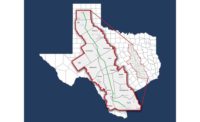Federal commitment, stronger ties to academia, specific standards and separation of planning from environmental permitting concerns are key to the future of high-speed rail in the U.S., according to a report released by the Marron Institute of Urban Management at New York University.
In Europe, the controversy is not over whether to build high-speed rail, but where to build it, noted Eric Goldwyn, lead author of the report, at a press briefing July 8. “In the U.S., there is controversy about both,” he said.
He added that while previous efforts at high-speed rail have failed, “this time, I think, is different.”
However, the Federal Railroad Administration or another governing body needs to establish technical standards, Goldwyn said, noting that the planned high-speed rail effort in Texas is using the Japanese rail standard, Brightline West is using the current U.S. railroad standard and California’s high-speed rail effort is considering a European standard.
“One engineer said that on paper, you can work out some stuff, but until you run Japanese rolling stock over American rail, we’re not totally sure it will work,” he said.
Goldwyn’s team interviewed 66 experts for the report, aided by the US High Speed Rail Association, he said.
Fabian Koark, COO of SAE Industry Technologies Consortia, said the industry group is working with relevant agencies to try to establish high-speed rail standards. “There can be no positive economic development without intercity connections,” he said. “Other parts of the world recognize that.”
He noted that when the Ukraine conflict began, gas prices soared in Europe, making driving or flying between metropolitan areas costly. “The trains were full, the roads were empty” he said.
Bryan Sooter, standards director with the American Public Transportation Association, said the FRA approached APTA in the 1990s about developing passenger rail equipment standards, but that more engineers are needed to promote them. “We don’t have enough engineers,” he said.
High-speed rail standards do exist, he added, noting that Japan’s Shinkansen system has been operating since 1964 with zero fatalities.
Other countries have universities focused on developing high-speed rail experts, said Goldwyn. “Companies pay students to go through programs,” he noted.
Sooter added that high-speed rail is “a system of systems” with standards for turnouts, track, equipment, etc. “It’s going to take collaboration through different organizations to get there” for high-speed rail as a whole, he said.
He said high-speed rail project sponsors “need to define the project and know what they want; design-bid-build is the best way to ensure that. There is room for design-build, but [sponsors would] need to procure an advanced set of designs, say 50 to 60 percent.”
Another concern is when project sponsors have to agree to pay for local betterments, he added. For example, the California High-Speed Rail Authority had to pay $202 million to a city in California that wanted grade separations, he said. Federal funds are “getting squandered on local betterments that are great for the communities, but not for the project,” he said. “Grade separations are great, but should the California High-Speed Rail Authority be the entity that pays for them?”
Ideally, once a project is defined, it gets permitted and “local plans have to adapt to it,” he added.
Project sponsors should also resist compressing environmental reviews and planning into one practice, he added. “The risk is that you focus on the environmental review and on developing projects that are not necessarily constructible,” he said. “In theory, it’s cheaper and faster if you combine them; in practice, not so much.”
Rather, project sponsors should develop the project plan, then mitigate environmental concerns, he said.
Above all, federal sustained commitment to high-speed rail is necessary, the trio agreed. They noted Amtrak’s history of facing political attempts to defund it, stating that it cannot be the primary torchbearer for a future high-speed rail system, However, Andy Byford, Amtrak’s vice president for high-speed rail development, chimed in that the agency is “deadly serious” about high-speed rail, with a plan to release an official strategy plan later this month.
Regarding the need for standardization, he added, “a rinse-and-repeat approach to rollouts of high-speed rail would be beneficial.”



